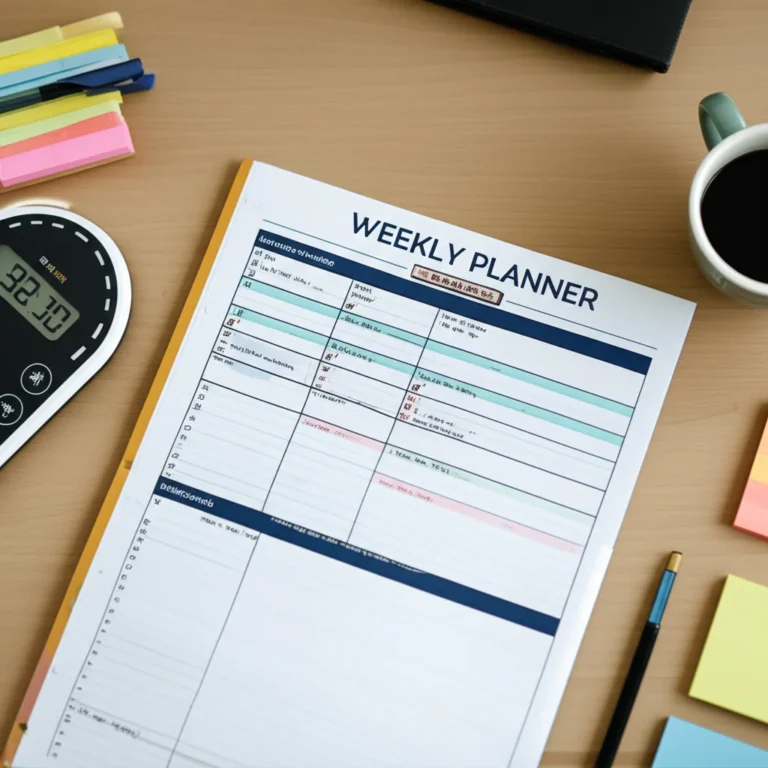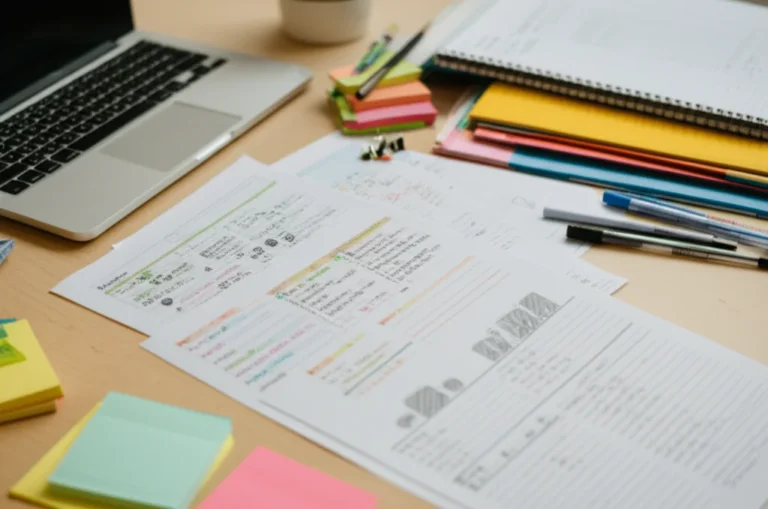Support our educational content for free when you buy through links on our site. Learn more
Mastering Lesson Plans: 10 Expert Strategies for Success (2025) 📚
Have you ever stared at a blank page, wondering how to craft a lesson plan that not only ticks all the boxes but also sparks genuine student engagement? You’re not alone! At Teacher Strategies™, we’ve seen countless educators wrestle with this very challenge. Did you know that well-structured lesson plans can boost student achievement by up to 20%? Yet, many teachers spend hours each week just trying to organize their thoughts and materials.
In this comprehensive guide, we’ll unravel the art and science of lesson planning—from setting crystal-clear objectives and aligning with curriculum standards to leveraging cutting-edge online tools like Planbook. Plus, we’ll share real-life examples, creative engagement tactics, and insider tips that will transform your planning process from daunting to downright delightful. Curious about the #1 teacher-preferred lesson planning platform and how it can save you hours? Stick around—you’ll find all that and more!
Key Takeaways
- Clear learning objectives are the compass guiding every effective lesson plan.
- Aligning with curriculum standards ensures relevance and compliance.
- Incorporate varied instructional strategies and assessments to engage diverse learners.
- Leverage technology platforms like Planbook to streamline planning and collaboration.
- Flexibility and reflection turn lesson plans into living documents that evolve with your classroom.
Ready to upgrade your lesson planning toolkit?
👉 Shop trusted lesson planning tools:
- Planbook on Amazon | Planbook Official Website
- Common Curriculum on Amazon | Common Curriculum Official
Table of Contents
- ⚡️ Quick Tips and Facts About Lesson Plans
- 📚 The Evolution and Importance of Lesson Planning in Education
- 📝 What Is a Lesson Plan? Key Components and Structure Explained
- 🎯 Setting Clear Learning Objectives: The Heart of Every Lesson Plan
- 🔍 How to Analyze Curriculum Standards and Align Your Lesson Plan
- 🛠️ Top 10 Essential Elements of an Effective Lesson Plan
- 📅 Step-by-Step Guide: Crafting a Comprehensive Lesson Plan That Works
- 💡 Creative Strategies to Engage Students Through Lesson Planning
- 🌐 Leveraging Technology: Best Online Lesson Planning Tools and Platforms
- 📊 Using Data and Assessment to Inform and Improve Your Lesson Plans
- differentiated-instruction-tailoring-lesson-plans-for-diverse-learners”>👩🏫 Differentiated Instruction: Tailoring Lesson Plans for Diverse Learners
- 🔄 Adapting and Revising Lesson Plans: Flexibility in Teaching
- 📖 Sample Lesson Plans: Real-Life Examples Across Subjects and Grades
- 🧰 The Established Leader in Online Lesson Planning: Why Teachers Choose Planbook
- 🏆 #1 Teacher-Preferred Online Lesson Planning Platform: Features and Benefits
- 💰 How Planbook Offers the Best Value for Full-Featured Lesson Planning
- 🤝 How Can We Assist You Today? Support and Resources for Lesson Planning
- 🦸♂️ Even Superheroes Need Help! Join Our Team and Make a Difference in Education
- 🔍 Frequently Asked Questions About Lesson Plans
- 📚 Recommended Links and Resources for Lesson Planning
- 📑 Reference Links and Further Reading
- 🎉 Conclusion: Mastering the Art of Lesson Planning
⚡️ Quick Tips and Facts About Lesson Plans
Welcome to the ultimate guide on lesson plans! Whether you’re a newbie teacher or a seasoned educator, we at Teacher Strategies™ know that lesson planning can feel like juggling flaming torches while riding a unicycle. But fear not! We’ve distilled years of classroom experience and research into quick tips and fascinating facts to get you started on the right foot.
Quick Tips to Supercharge Your Lesson Planning ✅
- Start with clear learning objectives — What do you want your students to actually learn? (Hint: This is your compass.)
- Align your plan with curriculum standards to ensure compliance and relevance.
- Include varied instructional strategies to engage different learning styles.
- Incorporate formative assessments to check understanding along the way.
- Build in flexibility — no plan survives first contact with students exactly as written!
- Use technology tools like Planbook or Google Classroom to save time and stay organized.
- Reflect and revise after each lesson to improve continuously.
Fascinating Facts About Lesson Plans 📊
| Fact | Explanation | Source |
|---|---|---|
| Teachers spend an average of 4-6 hours weekly on lesson planning | Planning is a significant time investment but pays off in smoother lessons. | EdWeek |
| Effective lesson plans increase student achievement by up to 20% | Structured planning correlates with better learning outcomes. | ASCD |
| Digital lesson planners reduce prep time by 30% on average | Tools like Planbook streamline organization and sharing. | Planbook.com |
Feeling overwhelmed? Don’t worry — we’ll unpack all this and more in the sections ahead. Ready to dive deeper? Let’s roll!
📚 The Evolution and Importance of Lesson Planning in Education
Lesson planning isn’t just a modern teacher’s headache — it’s a time-honored craft that has evolved alongside education itself. From chalkboards to smartboards, the core purpose remains: to create meaningful, effective learning experiences.
A Brief History of Lesson Plans
- Early Education: Ancient educators like Confucius and Socrates used informal lesson structures, relying heavily on dialogue and questioning.
- Industrial Revolution: The rise of formal schooling demanded standardized lesson plans to manage growing classrooms.
- 20th Century: The introduction of curriculum standards and behavioral objectives shaped lesson planning into a more scientific process.
- 21st Century: Digital tools and differentiated instruction have revolutionized how teachers plan and deliver lessons.
Why Lesson Planning Matters Today
- Ensures Alignment: Keeps teaching focused on standards and goals.
- Supports Differentiation: Helps tailor lessons to diverse learners.
- Promotes Reflection: Enables teachers to evaluate and improve their practice.
- Facilitates Collaboration: Shared plans foster teamwork among educators.
As we explore instructional strategies and lesson planning, remember that a great lesson plan is your roadmap to classroom success.
📝 What Is a Lesson Plan? Key Components and Structure Explained
At its core, a lesson plan is a detailed guide that outlines what happens during a class session. But what exactly does it include? Let’s break down the anatomy of a solid lesson plan.
Core Components of a Lesson Plan
- Lesson Title and Date
- Grade Level and Subject Area
- Learning Objectives — Specific, measurable goals for student learning.
- Materials and Resources — Books, technology, handouts, etc.
- Introduction/Hook — Engaging starter activity or question.
- Instructional Procedures — Step-by-step teaching activities.
- Guided Practice — Opportunities for students to practice with support.
- Independent Practice — Tasks students complete on their own.
- Assessment/Evaluation — How you’ll measure student understanding.
- Closure — Wrap-up and reflection.
- Differentiation Strategies — Adjustments for diverse learners.
- Reflection Notes — Post-lesson thoughts for improvement.
Sample Lesson Plan Template
| Section | Description | Example |
|---|---|---|
| Objective | What students will learn | “Students will be able to identify the parts of a plant.” |
| Materials | Needed items | “Plant diagram handouts, markers” |
| Procedure | Step-by-step plan | “1. Show video on plant parts. 2. Discuss key terms. 3. Label diagram.” |
| Assessment | How learning is checked | “Quiz on plant parts at end of lesson.” |
Want to see how this looks in action? Check out our 20 Powerful Application Activities for Your Lesson Plan 🚀 for creative ideas.
🎯 Setting Clear Learning Objectives: The Heart of Every Lesson Plan
If the lesson plan is a ship, then learning objectives are the compass. Without them, you risk drifting aimlessly.
Why Objectives Matter
- Focus Instruction: Keeps you and your students on track.
- Guide Assessment: Helps you decide what to test or observe.
- Clarify Expectations: Students know what success looks like.
Writing Effective Objectives: The SMART Way
Use the SMART criteria to craft objectives that are:
- Specific — Clear and focused.
- Measurable — Quantifiable outcomes.
- Achievable — Realistic for your students.
- Relevant — Aligned with standards and needs.
- Time-bound — Achievable within the lesson timeframe.
Example Objectives
- “By the end of the lesson, students will be able to solve two-step algebraic equations with 80% accuracy.”
- “Students will identify and describe three causes of the American Revolution.”
Pro tip: Use action verbs from Bloom’s Taxonomy like analyze, create, compare, or demonstrate to make objectives dynamic.
🔍 How to Analyze Curriculum Standards and Align Your Lesson Plan
Standards are the backbone of modern education, but they can feel like a tangled web. Here’s how to untangle and align them with your lesson plans.
Step 1: Identify Relevant Standards
- Start with your district or state’s curriculum framework (e.g., Common Core State Standards).
- Highlight the specific standards that match your lesson topic.
Step 2: Break Down the Standards
- Understand the skills and knowledge required.
- Note any prerequisite skills students should have.
Step 3: Map Objectives to Standards
- Ensure each objective directly supports a standard.
- Avoid objectives that don’t align — they dilute focus.
Step 4: Plan Assessments Based on Standards
- Design formative and summative assessments that measure mastery of standards.
Helpful Tools for Standards Alignment
| Tool | Features | Link |
|---|---|---|
| Planbook | Standards tagging, alignment tools | planbook.com |
| Common Curriculum | Standards library, lesson builder | commoncurriculum.com |
| Atlas Curriculum Mapping | District-wide alignment | rubicon.com |
Aligning your lesson plan with standards is like tuning an instrument — it ensures your teaching hits the right notes.
🛠️ Top 10 Essential Elements of an Effective Lesson Plan
Ready to build a lesson plan that dazzles? Here’s our expert list of the top 10 elements every plan needs:
- Clear Learning Objectives
- Engaging Hook or Introduction
- Step-by-Step Instructional Procedures
- Varied Teaching Methods (lecture, discussion, hands-on)
- Materials and Resources List
- Guided and Independent Practice Opportunities
- Formative and Summative Assessments
- Differentiation Strategies for Diverse Learners
- Closure and Reflection Activities
- Time Estimates for Each Activity
Why These Matter
Each element plays a role in keeping your lesson focused, engaging, and effective. Missing one? You might find students zoning out or the lesson running overtime.
📅 Step-by-Step Guide: Crafting a Comprehensive Lesson Plan That Works
Let’s get practical. Here’s a detailed walkthrough to create a lesson plan from scratch.
Step 1: Define Your Objective(s)
- Use SMART criteria (see above).
- Write them down clearly.
Step 2: Gather Materials and Resources
- List everything needed: textbooks, tech, handouts, manipulatives.
Step 3: Plan the Introduction
- Craft a hook: a question, video, or story that sparks curiosity.
Step 4: Outline Instructional Procedures
- Break down your teaching into manageable steps.
- Include examples, demonstrations, and checks for understanding.
Step 5: Design Guided Practice
- Plan activities where students apply new knowledge with your support.
Step 6: Plan Independent Practice
- Assign tasks for students to reinforce learning on their own.
Step 7: Develop Assessments
- Choose or create quizzes, projects, or observations to measure learning.
Step 8: Plan Closure
- Summarize key points and connect to future lessons.
Step 9: Include Differentiation
- Note modifications for students with different needs.
Step 10: Reflect and Revise
- After teaching, jot down what worked and what didn’t for next time.
💡 Creative Strategies to Engage Students Through Lesson Planning
Bored students? Not on our watch! Here are some creative strategies to spice up your lesson plans:
- Gamify Learning: Use quizzes, competitions, or escape room challenges.
- Project-Based Learning: Let students explore real-world problems.
- Storytelling: Weave narratives to make concepts memorable.
- Multisensory Activities: Incorporate visuals, sounds, and hands-on tasks.
- Collaborative Learning: Plan group work and peer teaching.
- Flipped Classroom: Assign videos for homework and use class time for active learning.
Remember, engagement is the secret sauce that turns a good lesson into a great one. For more ideas, explore our Instructional Strategies category.
🌐 Leveraging Technology: Best Online Lesson Planning Tools and Platforms
Technology can be your best friend or your worst enemy in lesson planning. Here’s a rundown of the top platforms that teachers swear by.
Lesson Planning Platforms Comparison Table
| Platform | Design & Usability (1-10) | Functionality (1-10) | Collaboration Features (1-10) | Integration | Link |
|---|---|---|---|---|---|
| Planbook | 9 | 9 | 8 | Google Classroom, Standards | planbook.com |
| Common Curriculum | 8 | 8 | 9 | Standards, Google Drive | commoncurriculum.com |
| Chalk | 8 | 7 | 9 | Standards, SIS | chalk.com |
| Google Classroom | 7 | 8 | 10 | Google Suite | classroom.google.com |
Why Planbook Leads the Pack
- Intuitive interface that saves time.
- Standards tagging for easy alignment.
- Sharing and collaboration with colleagues.
- Mobile-friendly for planning on the go.
Drawbacks to Consider
- Some features require paid subscription.
- Learning curve for first-time users.
Real Teacher Voices
“Planbook cut my planning time in half and made sharing with my team effortless.” — Sarah M., 5th Grade Teacher
“I love how I can tag standards and pull reports for admin.” — James L., Middle School Science
👉 CHECK PRICE on:
- Planbook: Amazon | Planbook Official Website
- Common Curriculum: Amazon | Common Curriculum Official
📊 Using Data and Assessment to Inform and Improve Your Lesson Plans
Data-driven teaching isn’t just a buzzword — it’s a game changer. Here’s how to use assessment data to refine your lesson plans.
Types of Assessments to Include
- Formative: Quick checks during lessons (exit tickets, polls).
- Summative: Tests or projects at the end of units.
- Diagnostic: Pre-assessments to gauge prior knowledge.
How to Use Data Effectively
- Analyze student responses to identify misconceptions.
- Adjust pacing or content based on mastery levels.
- Differentiate instruction for students needing extra support.
Tools for Data Collection
- Google Forms and quizzes.
- Learning management systems (LMS) with analytics.
- Apps like Kahoot! and Quizizz for instant feedback.
Data isn’t just numbers — it’s your classroom’s story. Use it to write better lessons!
👩🏫 Differentiated Instruction: Tailoring Lesson Plans for Diverse Learners
Every student is unique, and your lesson plans should reflect that. Differentiation is the art of meeting students where they are.
Differentiation Strategies
- Content: Vary reading materials or complexity.
- Process: Offer choices in how students engage with material.
- Product: Allow different ways to demonstrate learning (essay, video, poster).
- Learning Environment: Create quiet zones or collaborative spaces.
Incorporating Differentiation in Your Lesson Plan
- Identify student needs through assessments or observations.
- Plan tiered activities with varying difficulty.
- Use flexible grouping strategies.
Resources for Differentiated Instruction
Explore our Differentiated Instruction category for practical guides and examples.
🔄 Adapting and Revising Lesson Plans: Flexibility in Teaching
No plan survives contact with students exactly as imagined. Flexibility is your secret weapon.
When to Adapt Your Lesson Plan
- Student engagement is low.
- Unexpected questions or interests arise.
- Timing is off — too fast or too slow.
- Technology glitches or resource issues.
How to Revise Effectively
- Keep notes on what worked and what didn’t.
- Solicit student feedback.
- Collaborate with colleagues for fresh ideas.
- Use formative assessments to guide changes.
Remember, a lesson plan is a living document — embrace the evolution!
📖 Sample Lesson Plans: Real-Life Examples Across Subjects and Grades
Sometimes, the best way to learn is by example. Here are snippets from actual lesson plans across subjects and grade levels.
Science: 7th Grade – Chesapeake Bay Ecosystem
- Objective: Students will explain the impact of invasive species on local ecosystems.
- Hook: Show a short video on invasive blue crabs.
- Activities: Group research, food web creation, role-play debate.
- Assessment: Presentation and quiz.
English: 9th Grade – Analyzing Poetry
- Objective: Students will identify metaphors and similes in selected poems.
- Hook: Read a dramatic poem aloud.
- Activities: Annotate texts, small group discussion, creative writing.
- Assessment: Written analysis.
Math: 4th Grade – Multiplication Concepts
- Objective: Students will multiply two-digit numbers using area models.
- Hook: Use manipulatives to build arrays.
- Activities: Guided practice with worksheets, partner games.
- Assessment: Exit ticket problems.
For more inspiration, check out the extensive VA SEA Lesson Plans which offer science-focused, classroom-tested plans with downloadable resources.
🧰 The Established Leader in Online Lesson Planning: Why Teachers Choose Planbook
If you’re hunting for an online lesson planner that combines simplicity, power, and collaboration, Planbook is a top contender. Here’s why educators keep coming back.
Planbook Rating Table (1-10 Scale)
| Aspect | Rating | Notes |
|---|---|---|
| Design & Usability | 9 | Clean, intuitive interface |
| Functionality | 9 | Robust features including standards tagging |
| Collaboration | 8 | Easy sharing with colleagues |
| Customer Support | 8 | Responsive and helpful |
| Price Value | 9 | Competitive pricing for features |
Features That Shine
- Standards Alignment: Tag and track standards effortlessly.
- Flexible Scheduling: Daily, weekly, or custom views.
- Sharing & Printing: Share plans with parents, admins, or colleagues.
- Mobile Access: Plan on the go with apps and responsive design.
What Users Say
“Planbook makes lesson planning less of a chore and more of a joy.” — Linda K., Elementary Teacher
“The ability to link standards and print customized plans is a lifesaver.” — Mark D., High School Teacher
Considerations
- Some advanced features require a paid subscription.
- Initial setup can take time but pays off in the long run.
🏆 #1 Teacher-Preferred Online Lesson Planning Platform: Features and Benefits
Why is Planbook the #1 choice for many educators? Let’s break down the benefits.
Benefits for Teachers
- Time Savings: Automate recurring lessons and reuse plans.
- Organization: Centralized storage prevents lost papers.
- Customization: Tailor plans to your teaching style and student needs.
- Integration: Works smoothly with Google Classroom and other platforms.
Benefits for Schools and Districts
- Standardization: Ensures alignment across classrooms.
- Data Security: FERPA-compliant privacy and security measures.
- Professional Development: Supports coaching and collaboration.
Comparison with Other Platforms
| Feature | Planbook | Common Curriculum | Chalk |
|---|---|---|---|
| Standards Tagging | ✅ | ✅ | ✅ |
| Mobile App | ✅ | Limited | ✅ |
| Collaboration | ✅ | ✅ | ✅ |
| Integration with LMS | ✅ | Limited | ✅ |
| Price | Competitive | Mid-range | Higher |
💰 How Planbook Offers the Best Value for Full-Featured Lesson Planning
When it comes to balancing features, ease of use, and cost, Planbook stands out.
What You Get with Planbook
- Unlimited lesson plans and classes.
- Standards library and tagging.
- Sharing and printing options.
- Cloud storage and backups.
- Customer support and tutorials.
Why It’s Worth It
- Saves hours of planning time weekly.
- Reduces stress with organized, accessible plans.
- Supports diverse instructional needs.
Alternatives and When to Consider Them
- If your school uses Google Classroom heavily and prefers free tools, Google Classroom’s built-in planner may suffice.
- For district-wide curriculum mapping, Rubicon Atlas may be better but at a higher cost.
🤝 How Can We Assist You Today? Support and Resources for Lesson Planning
At Teacher Strategies™, we’re here to help you master lesson planning with expert advice, resources, and community support.
Resources We Offer
- Step-by-step guides like this one.
- Templates and samples to jumpstart your planning.
- Instructional coaching to refine your approach.
- Webinars and workshops on best practices.
- Community forums for peer support.
Need Personalized Help?
Reach out to us anytime for coaching or to discuss challenges. Remember, even superheroes need help sometimes! 🦸♀️
🦸♂️ Even Superheroes Need Help! Join Our Team and Make a Difference in Education
Are you passionate about teaching and eager to support fellow educators? Join the Teacher Strategies™ team!
Why Join Us?
- Collaborate with experts in instructional coaching and classroom management.
- Contribute to resources that empower thousands of teachers.
- Flexible roles for writers, coaches, and trainers.
How to Apply
Visit our careers page or contact us directly to learn about openings. Your expertise can transform classrooms everywhere!
🔍 Frequently Asked Questions About Lesson Plans
Q1: How detailed should my lesson plan be?
A: It depends on your style and context. Some teachers prefer bullet points; others write scripts. The key is clarity and usability.
Q2: How often should I update my lesson plans?
A: After each lesson, reflect and revise as needed. Also, update plans when curriculum standards or student needs change.
Q3: Can I share my lesson plans with other teachers?
A: Absolutely! Sharing promotes collaboration and consistency. Online platforms like Planbook make this easy.
Q4: What if my lesson doesn’t go as planned?
A: Adapt on the fly! Flexibility is essential. Use your reflections to improve future plans.
For more FAQs, visit our Lesson Planning FAQ page.
📚 Recommended Links and Resources for Lesson Planning
- Planbook Official Website — Leading online lesson planner.
- Common Curriculum — Collaborative lesson planning tool.
- VA SEA Lesson Plans — Free, science-focused lesson plans.
- Bloom’s Taxonomy Verbs — Guide to writing objectives.
- Edutopia Lesson Planning Tips — Expert advice and strategies.
📑 Reference Links and Further Reading
- Common Core State Standards Initiative
- ASCD on Lesson Planning EdWeek: Teacher Time on Lesson Planning
- Planbook Terms of Service and Privacy
- Teacher Strategies™ Instructional Coaching
- Teacher Strategies™ Differentiated Instruction
Before we wrap up, if you’re feeling stuck or overwhelmed, don’t miss the featured video “If You Struggle With Lesson Planning as a Teacher: WATCH THIS!” by Pocketful of Primary. It’s a treasure trove of practical advice and motivation — check it out here! 🎥
Stay tuned for the conclusion where we tie it all together and share our final recommendations!
🎉 Conclusion: Mastering the Art of Lesson Planning
After this deep dive into the world of lesson plans, you’re now equipped with the tools, strategies, and insider tips to transform your teaching practice. Remember, a lesson plan isn’t just a document — it’s your blueprint for success, your classroom’s GPS, and your secret weapon against chaos.
The Planbook Verdict: Pros and Cons
If you’re considering an online lesson planner, Planbook stands out as a trusted, teacher-preferred platform that balances power with simplicity.
Positives:
✅ Intuitive design that saves time
✅ Robust standards alignment and tagging
✅ Easy sharing and collaboration features
✅ Mobile-friendly for planning anywhere
✅ Competitive pricing with excellent value
Negatives:
❌ Some advanced features require a subscription
❌ Initial setup can be time-consuming for new users
Our Recommendation: For educators serious about streamlining their lesson planning while maintaining flexibility and alignment with standards, Planbook is a top-tier choice that delivers consistent value. It’s a platform that grows with you and your classroom needs.
Closing the Loop
Remember the question we teased earlier: How do you keep lesson plans flexible yet effective? The answer lies in embracing lesson plans as living documents — plan with purpose, teach with passion, and revise with reflection. With the right mindset and tools, lesson planning becomes less of a chore and more of a creative, rewarding process.
Ready to take your lesson planning to the next level? Dive into the resources, experiment with technology, and never hesitate to seek support. You’ve got this! 🚀
📚 Recommended Links and Shopping Resources
Elevate your lesson planning toolkit with these trusted products and resources:
-
Planbook Online Lesson Planner:
Amazon | Planbook Official Website -
Common Curriculum Lesson Planning Tool:
Amazon | Common Curriculum Official -
Chalk Lesson Planning Platform:
Amazon | Chalk Official Website -
Books for Lesson Planning Mastery:
-
VA SEA Lesson Plans | Marine Advisory Program | Virginia Institute of Marine Science:
Explore Lesson Plans
🔍 Frequently Asked Questions About Lesson Plans
What are the key components of an effective lesson plan?
An effective lesson plan includes clear learning objectives, engaging introductions, detailed instructional procedures, guided and independent practice, assessments, differentiation strategies, and closure activities. These components ensure the lesson is focused, interactive, and measurable. Including reflection notes helps improve future lessons.
How can I create a lesson plan that engages all students?
Engagement stems from variety and relevance. Incorporate multisensory activities, real-world connections, collaborative tasks, and technology. Use hooks like storytelling or gamification to spark curiosity. Vary instructional methods to cater to different learning styles and keep energy high.
What strategies can I use to differentiate my lesson plans?
Differentiation can be applied to content, process, product, and learning environment. Use tiered assignments, flexible grouping, choice boards, and scaffolded supports. Assess students’ readiness and interests to tailor lessons that challenge and support everyone.
How do I align lesson plans with curriculum standards?
Start by identifying the relevant standards from your district or state framework. Break down the skills and knowledge required, then map your learning objectives and assessments directly to those standards. Use tools like Planbook to tag standards for easy tracking.
What are some tips for managing time within a lesson plan?
Estimate time for each activity conservatively, leaving buffer periods for transitions and unexpected questions. Prioritize essential content and be ready to adapt pacing. Use timers or visual cues to keep students on track, and plan closure activities that reinforce learning without overrunning.
How can I incorporate technology into my lesson plans?
Leverage digital platforms like Planbook for organization, Google Classroom for assignments, and apps like Kahoot! or Quizizz for interactive assessments. Use multimedia resources to diversify instruction and provide access to virtual labs, simulations, or videos that enhance understanding.
What assessment methods work best in lesson planning?
A mix of formative (exit tickets, polls, observations) and summative assessments (tests, projects) works best. Formative assessments provide ongoing feedback to adjust instruction, while summative assessments evaluate mastery. Incorporate self-assessment and peer feedback to deepen learning.
How do I adapt lesson plans for diverse learning styles?
Incorporate visual, auditory, kinesthetic, and reading/writing activities. Offer multiple ways for students to engage with content and demonstrate understanding. Use flexible grouping and provide choices in assignments to accommodate preferences and strengths.
How do I handle unexpected changes during a lesson?
Remain flexible and ready to pivot. Have backup activities or simplified versions of your lesson. Use student feedback and formative assessments to guide on-the-fly adjustments. Reflect afterward to improve future plans.
How can I collaborate with colleagues on lesson planning?
Use shared online platforms like Planbook or Google Drive to co-create and share lesson plans. Schedule regular planning meetings and share best practices. Collaboration fosters consistency and innovation across classrooms.
📑 Reference Links and Further Reading
- Planbook Official Website — Trusted online lesson planning platform.
- Common Core State Standards Initiative — National curriculum standards.
- ASCD on the Importance of Lesson Planning
- EdWeek: How Much Time Teachers Spend Planning
- Bloom’s Taxonomy Guide — For writing effective learning objectives.
- VA SEA Lesson Plans | Marine Advisory Program | Virginia Institute of Marine Science — Extensive science lesson plans and resources.
- Teacher Strategies™ Instructional Coaching
- Teacher Strategies™ Differentiated Instruction
With these insights and resources, you’re ready to conquer lesson planning like a pro. Remember, every great lesson starts with a great plan — and you’re well on your way! 🌟








